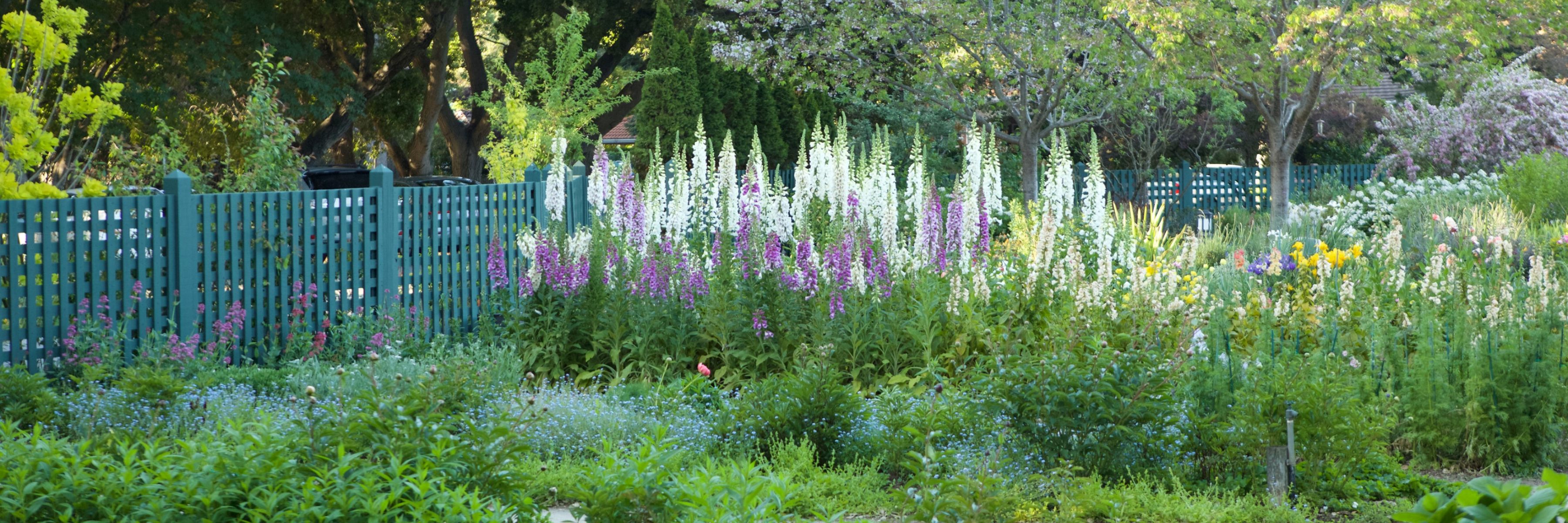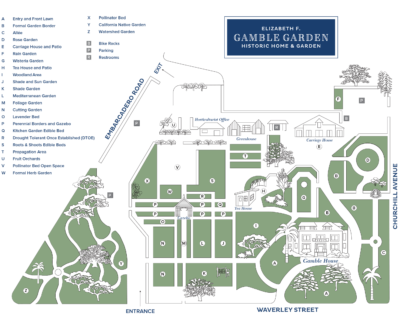
Self-Guided Tours
We hope this description will give you a deeper appreciation of the house and garden.
Gamble Garden is located at 1431 Waverley Street, Palo Alto, CA 94301. The office in the house is open 9 am-2 pm, weekdays. Please note that the house and south side of the garden are often closed on Saturday and Sunday afternoons for special events. Please observe the signs posted.
The Colonial/Georgian Revival house was built by 1904 for $6,039 by San Jose contractor C.A. Bates. The original house was later enhanced by minor additions. It has been designated a Point of Historical Interest by the State of California.
A. Entry and Front Lawn
This entry area is defined by a circular drive first used for carriage access, later for cars. The wrought iron gates are original.
Three surviving Canary Island Date Palms (Phoenix canariensis) recall the interest in exotic plants when the Gamble family bought the property shortly after 1900.
Two Southern Magnolias (M. grandiflora), notable for their leathery foliage, large blossoms, and surface root structure, probably were planted about 1950.
Two Japanese Maples (Acer palmatum) on either side of the porch were added in the late 1990s.
B. Formal Garden Border
The shrub border that reaches from Waverley Street to the Churchill parking area helps create separate garden rooms, a feature of gardens in early 1900 garden. The brick path was originally a driveway to the Carriage House.
C. Allée
The design of this classic Victorian garden room emphasizes the view from the bench to the grotto fountain. Notice the original Gamble family sundial.
The allée features flowering crabapple trees (Malus ‘Sugar Tyme’).
The Boxwood hedge (Buxus sempervirens) creates order and encloses plantings of Vinca minor and spring-flowering bulbs.
D. Rose Garden
A strong design statement in this garden room is made by the central ring of white roses (R. ‘Iceberg’) under-planted with Catmint (Nepeta x faassenii) and surrounded by some 50 selected heritage roses, identified by green labels with historical information.
The Gamble family played the game of clock golf on the central grass circle. Recreational use of the lawn was often a feature of early 1900 gardens.
E. Carriage House and Patio
The Gamble Family’s horses and carriages and later their automobiles were kept in the Carriage House. The upper window provided access to the hayloft. Modified in 1987, it is now used for lectures, business seminars, and social gatherings.
The handsome Red Oak shelters the brick patio, and a hedge of the hybrid Camellia ‘Coral Delight’ is planted against the wooden fencing.
Tucked away in the corner you’ll find the Turk’s Cap (Malvaviscus arboreus var. Mexicana), a red flowering shrub in the mallow family, popular at the turn-of-the 20th century.
Carriage House Patio and Parking Area Borders
Here you find historic Japanese Wisteria (W. longissima) and Coast Redwood (Sequoia sempervirons ‘Apros blue’.)
F. Rain Garden
Rainwater from the Carriage House roof is captured in the 260-gallon storage tank. Once the tank is full, water is diverted to the Rain Garden, where it slowly sinks in and replenishes the groundwater. Storage tank water can also be used to water the gardens nearby as the need arises.
G. Wisteria Garden
A few double lavender Japanese Wisteria (W. floribunda ‘Violacea-Plena’) are original plantings, others have been propagated from cuttings. A simpler single Wisteria (W. floribunda ‘Purpurea’) is at the fountain end.
The Boxwood hedge (Buxus sempervirens) along the brick path defines a space for perennials, annuals, and bulbs.
Trees and shrubs include a Paperbark Maple (Acer griseum), four American Arborvitae (Thuja occidentalis ‘Emerald Green’), Banana Shrub (Michelia figo), Deutzia (D. scabra ‘Pride of Rochester’) and a pair of Magnolias (M. ‘Star Wars’)
This is a favorite site for weddings.
H. Tea House and Patio
In 1948 Elizabeth Gamble commissioned Allan Hines Reid to design this area as a meeting and outdoor entertaining space for community groups.
Note the Cat’s Claw Vine (Macfadyena unguis-cati) growing on the trellis and the many handsome pots featuring shade-loving plants.
The Cockspur Coral Tree (Erythrina crista-galli) behind the Tea House is the national tree of Argentina. It requires mild winters and a sheltered location to thrive.
I. Woodland Area
Many varieties of Dogwood (Cornus), Camellia, Rhododendron, Azalea, and Hydrangea flourish under spreading Oaks.
Through the Heritage Plant Project camellias, rhododendrons, viburnums, tree peonies and daffodils known to have been in Miss Gamble’s garden, or in other early 20th century California gardens, have been added to the Woodland Garden. Green signage identifies these heritage plants.
Our camellia collection of over 70 varieties is on the American Camellia Society Trail Map.
J. Shade and Sun Garden
This area transitions from woodland to the Mediterranean coast, high to low, shade to sun.
Salvias and other perennials, shrubs, and trees coexist harmoniously.
K. Shade Garden
This peaceful area combines textures of Ferns, Hellebores, Japanese Anemones, Hydrangea, and other shade-loving plants. Look for the unusual Cucumber Tree (Magnolia acuminata) sheltering beneath the oaks.
L. Mediterranean Garden
Four raised beds highlight the four Mediterranean climates around the world: the Mediterranean Basin, Australia, Chile, and South Africa. These four quadrants are best seen in spring, after winter rains. During the summer, the drought-tolerant plants receive little irrigation.
M. Foliage Garden
These two beds demonstrate garden design achieved by using plants known for their foliage, combining a variety of shapes, textures, and colors for dramatic effect.
N. Cutting Garden
These working beds change with the seasons and are for the exclusive use of the Gamble Garden flower arrangers whose weekly bouquets decorate the house.
O. Iris Bed
The Bearded Iris was a favorite of Miss Gamble. The bed features Dykes Medal winners from 1928–1969. In 1994, Lois O’Brien, a friend of Elizabeth Gamble, hybridized the blue ‘Elizabeth Gamble’ iris.
P. Perennial Borders and Gazebo
Observe the different colors, forms, and textures in the perennial beds, where plants were selected to highlight different color combinations and grow no taller than 5 feet.
The Gazebo forms a strong vertical accent with vines of Sweet Autumn Clematis (C. terniflora) and Porcelain Berry (Ampelopsis brevipedunculata) shading the Endowment Bronze Medallion, surrounded by individual donor bricks.
Q. Kitchen Garden
These plants are used in preparing the Garden Fresh Lunches served monthly in the Main House.
R. Drought Tolerant Once Established
This bed features plants that tolerate drought once they have become established, two or three years after planting.
S. Roots & Shoots
This award-winning intergenerational garden was begun in 1984. It pairs seniors with third-grade students in a curriculum of vegetable gardening from A to Z. The bee house creates a habitat for native bees and helps increase their population. Native bees do not live in hives but lay their eggs in trees or fallen logs on the ground.
T. Propagation Area
The Greenhouse is used for the propagation of new annuals and perennials. Shade plants are stored in the Lath House. Cold frames protect seedlings. Plants for sale during special events such as Spring Tour are displayed nearby.
U. Orchard Area
Espaliers of antique varieties of apples and pears demonstrate pruning techniques for increasing fruit production. The citrus trees provide year-round interest with their blossoms, fruit, foliage, and sculpted winter form.
Note the variety of succulents near the horticulturist’s office.
V. Pollinator Bed Open Space
The handsome aged Coast Live Oak (Quercus agrifolia) died during the summer of 2017. This sunny area welcomes pollinator plants and serves as a gathering place for various garden activities.
W. Formal Herb Garden
The small herb garden with a strong formal pattern outlined by Buxus sempervirens ‘Green Beauty’ provides a framework to highlight herbs used in Italian, French, Asian, and South American cuisines.
X. Pollinator Garden
With the loss of the Great Oak and the dappled shade it provided, the mixed border using shrubs, perennials, annuals, and bulbs, did not thrive in the increased exposure to the sun. A pollinator garden full of plants that provide a source of pollen and nectar to attract bees, butterflies, birds, and a wide variety of other creatures was added in the spring of 2019. An owl house was installed to attract a resident owl to provide natural pest control for the garden.
Behind Pollinator Garden Parking Area Borders
Quince (Chaenomeles), Forsythia, and Mock Orange (Philadelphus) are featured behind the fence of the Pollinator Garden. Opposite are native Coast Live Oak (Quercus agrifolia) and Buckeye (Aesculus), with Sugar Bush (Rhus ovate) planted beneath.
Y. Native Garden
In 2000, Gamble Garden became stewards of the .3-acre parcel that features water-wise California Native Plants, including many Pacific Coast Iris hybrids that bloom in late winter.
Z. Watershed Garden
This area features a watershed garden that is designed to retain rainwater instead of runoff to storm drains. The rainwater filters through permeable materials, climate-appropriate plants, and good soil, therefore replenishing the underground aquifers free of pollutants.
